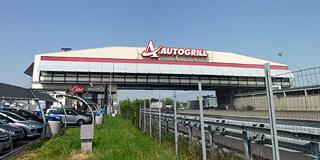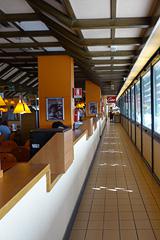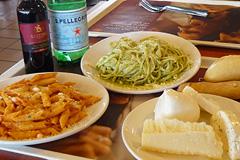 If you are Italian, or if you have driven around Italy, you are probably familiar with "Autogrill" as a chain of restaurants that serve the highways all throughout the country.
If you are Italian, or if you have driven around Italy, you are probably familiar with "Autogrill" as a chain of restaurants that serve the highways all throughout the country.But even if you are unaware of Autogrill, every time you travel you are actually exposed to the Autogrill Group, a catering giant that runs several licensed franchises (including Burger King, Pizza Hut and Starbucks) in the airports, train stations and ports of over 40 countries worldwide (including USA, Canada and Australia).
Even though the Autogrill Group is based in Italy, to most Italians "Autogrill" is just the generic name of the restaurants located on the highway - even of the ones that are run by the competition (e.g.: Chef Express, Ristop), or that are branded differently because of their size (e.g.: Ciao, Spizzico). And this despite the fact that Autogrill restaurants are nowadays common also in major city centers. The Autogrill name is so universal that in the rest of this article we will also use it as a synonym of highway restaurant.
Italians like Autogrill because it's familiar and reliable, because it's good value for money, and because it can be conveniently accessed without leaving the highway. This detail is particularly important, given that most Italian highways are toll roads and exiting them requires the drivers to go through the time consuming pay booths. Foreigners like Autogrill because it involves very little interaction with (Italian speaking) staff, and because of the high quality of its food, especially compared to the greasy North American road-side restaurants.

The bridge-style Autogrill
(above), from the inside.
- A mini-supermarket with snacks and regional foods (such as olive oil, dried pasta, wine, cheese, cured meats), over-the-counter drugs, toiletries, music CDs, batteries, newspapers and magazines; tobaccos and pre-paid phone cards can be purchased at the cashier.
- A coffee bar which sells espresso drinks, pastries, and (often) grilled sandwiches ('panini', in Italian, plural of 'panino'), such as Camogli (made with focaccia, Italian ham and swiss), Rustico (with pancetta, smoked provolone and tomatoes) and Fattoria (with speck and fontina cheese).
- A separate cafeteria-style restaurant.

A meal for two: penne all'arrabbiata,
linguine al pesto, cheese plate,
red wine, sparkling water and bread.
In conclusion, Autogrill is dear to the Italians and very much part of their collective imaginary. Every aspect of this Italian icon reflects the spirit of Italy, from the mini-supermarket that resembles the neighborhood shop, to the traditional coffee bar, to the family-style food served in the cafeteria. For those rushing through Italy in their first European trip, Autogrill can give a pretty good snapshot of Italy and of the Italians and shouldn't be missed.

